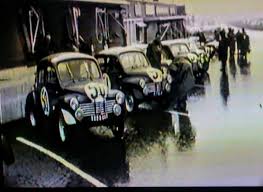The 1951 24 Hours of Le Mans was the 19th edition of the event and took place on June 23 and 24, 1951 on the Circuit de la Sarthe. This was the second time that 4CVs participated in Le Mans, but the first time as an Official Renault Team, and they would participate until 1953.
Renault lined up with five 4CV R1063s, a sixth example was registered privately by the company Satecmo which produces gearboxes. Of the 6, 3 finished the event. The first of the 4CVs ranked 23rd overall out of 60 with 189 laps and an average speed of 111.156 km/h, ranking 1st in its category, while the winner of the event won with 267 laps on a Jaguar XK120-C.

The cars were prepared in department 153, the special testing workshop which also had to take care of the other productions of the Régie, the Frégate or the Paris/Cape expeditions for example, which posed problems of staffing and budget. A racing department was then created, department 833. It was headed from 1 August 1951 by Fr Landon who managed the entire organisation, travel, accommodation, budget, etc.
The 1063, derived from the standard 4 CV, was the first sports version derived from a popular Renault model, it paved the way for the Dauphines Gordini, 1093 and other R 8S and Gordini. Thirty examples were immediately manufactured, then others in several stages to reach the total of eighty which were delivered to hand-picked drivers. Then, a special kit 1063 provided by SAPAR allows to modify a standard 4 CV, to transform it into a racing car and to homologate it. A hundred different parts are catalogued for the great delight of aspiring champions.

The changes
The engine - the compression ratio increases to 9.5, one or two Solex double-body carburetors and special intake and exhaust pipes, the cylinder head is modified to fit special tulip valves, the special camshaft (SATECMO); intake opening 11 ° intake closing 55 °; exhaust opening 45 ° exhaust closing 7 °, 4-liter oil pan and improved cooling, dural connecting rods (CBP) balanced crankshaft, but original. Depending on the version, the power can climb from 35 to 45 hp at 5,600 rpm and the speed to 140 km/h. The assembly with four rear shock absorbers that will be found on the R 8 Gordini.

Front axle — four additional teeth on the direct steering rack without return spring, new shock absorbers.
Brakes — initially original drum plus an aluminum hoop for better cooling, then larger drum from the Juvaquatre.

Bodywork — the front wings are cut out for brake cooling, depending on the event the bumpers are removed and headlights are added to the front. The hoods are made of aluminum, the door windows are made of plexiglass, a tank is placed in the location of the rear bench seat or fixed in the front trunk. Rev counter, water temperature, voltmeter adorn the dashboard; for winter rallies, an electric defroster is fixed to the base of the windshield, which will cause dynamo problems. The front seats are lightened and made of simple elastic straps (like a… 2CV!)… This is the recipe for the magic potion applied to the little 4 CV, each 1063 is different.












Comments